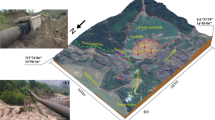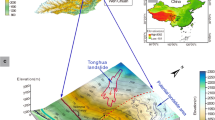Abstract
Due to excavations and continuous rainfall, two landslides occurred on February 9, 2018, and July 28, 2019, respectively, in the quarry of the Changdifang Reservoir engineering area, in Yingjiang County, Yunnan Province, China. The volume of the second landslide was approximately 2.4 × 105 m3, threatening the safety of construction workers and the hydropower station project construction severely. In order to explore the causes of these two landslides, the geological and hydrological conditions and the current excavation status of the landslide area were investigated, the relationship between rainfall and the displacement of the landslide body was compared and analyzed, and the landslide process and failure characteristics were described in detail. The failure mechanism of these two landslides were distinguished: (1) the poor rock mass properties, due to the strong weathering and tectonic joint of the rock mass; (2) the steep slope (of 63° in largest dip angle) induced by the slope excavation, as well as (3) the continuous heavy rainfall. The unfavorable geological condition was a determinant factor, and the combined effects of excavation and continuous rainfall were triggering factors that induced the landslide. The research results show that the displacement of the landslide body has significant seasonal characteristics. In the rainy season, there is a significant acceleration of displacement, and the slow displacement will remain for a long time after the rainy season. Consequently, it is very necessary to take reasonable slope treatment measures and continue to monitor the slope.


















Similar content being viewed by others
Data availability
The data used to support the findings of this study are available from the corresponding author upon request.
References
Alhomoud AS, Tubeileh TK (1998) Analysis and remedies of landslides of cut slopes due to the presence of weak cohesive layers within stronger formations. Environ Geol 33(4):299–311
Askarinejad A, Casini F, Bischof P et al (2012) Rainfall induced instabilities: a field experiment on a silty sand slope in northern Switzerland. Ital Geotech J 3:50–71
Cen DF, Huang D, Ren F (2017) Shear deformation and strength of the interphase between the soil-rock mixture and the benched bedrock slope surface. Acta Geotech 12(2):391–413
Chung MC, Tan CH, Chen CH (2017) Local rainfall thresholds for forecasting landslide occurrence: Taipingshan landslide triggered by typhoon Saola. Landslides 14:19–33
Cogan J, Gratchev I, Wang GH (2018) Rainfall-induced shallow landslides caused by ex-Tropical Cyclone Debbie, 31st March 2017. Landslides 15(6):1215–1221
Cui Y, Jiang Y, Guo C (2019) Investigation of the initiation of shallow failure in widely graded loose soil slopes considering interstitial flow and surface runoff. Landslides 16:815–828
Dhahri F, Benassi R, Mhamdi A, Zeyeni K, Boukadi N (2016) Structural and geomorphological controls of the present-day landslide in the Moulares phosphate mines (western-central Tunisia). Bull Eng Geol Environ 75(4):1459–1468
Erginal A, Türkeş M, Ertek T et al (2008) Geomorphological investigation of the excavation-induced Dündar landslide, Bursa -Turkey. Geogr Ann Ser A Phys Geogr 90(2):109–123
Froude MJ, Petley D (2018) Global fatal landslide occurrence from 2004 to 2016. Nat Hazards Earth Syst Sci 18:2161–2181
Gu DM, Huang D, Yang WD, Zhu JL, Fu GY (2017) Understanding the triggering mechanism and possible kinematic evolution of a reactivated landslide in the Three Gorges reservoir. Landslides 14(6):2073–2087
Huang RQ, Pei XJ, Cui SH (2016) Cataclastic characteristics and formation mechanism of rock mass in sliding zone of Daguangbao landslide. Chin J Rock Mech Eng 35(1):1–15
Huang D, Gu DM, Song YX, Cen DF, Zeng B (2018) Towards a complete understanding of the triggering mechanism of a large reactivated landslide in the Three Gorges reservoir. Eng Geol 238:36–51
Li WC, Dai FC, Wei YQ, Wang ML, Min H, Lee LM (2016) Implication of subsurface flow on rainfall-induced landslide: a case study. Landslides 13(5):1109–1123
Lin Q, Wang Y (2018) Spatial and temporal analysis of a fatal landslide inventory in China from 1950 to 2016. Landslides 15(12):2357–2372
Lin L, Lin Q, Wang Y (2017a) Landslide susceptibility mapping on a global scale using the method of logistic regression. Nat Hazards Earth Syst Sci 17:1411–1424
Lin Q, Wang Y, Liu T, Zhu Y, Sui Q (2017b) The vulnerability of people to landslides: a case study on the relationship between the casualties and volume of landslides in China. Int J Environ Res Public Health 14:212
Lin F, Wu LZ, Huang RQ, Zhang H (2018) Formation and characteristics of the Xiaoba landslide in Fuquan, Guizhou, China. Landslides 15(4):669–681
Marschalko M, Yilmaz I, Bednárik M, Kubečka K (2012) Influence of underground mining activities on the slope deformation genesis: Doubrava Vrchovec, Doubrava Ujala and Staric case studies from Czech Republic. Eng Geol 147-148:37–51
Massey CI, Petley DN, McSaveney MJ, Archibald G (2016) Basal sliding and plastic deformation of a slow, reactivated landslide in New Zealand. Eng Geol 208:11–28
Ng CWW, Bordoloi S, Ng CWW (2020) The effects of vegetation traits and their stability functions in bio-engineered slopes: a perspective review. Eng Geol 105742
Ouyang CJ, Zhou KQ, Xu Q, Yin JH, Peng DL, Wang DP, Li WL (2017) Dynamic analysis and numerical modeling of the 2015 catastrophic landslide of the construction waste landfill at Guangming, Shenzhen, China. Landslides 14(2):705–718
Petley D (2012) Global patterns of loss of life from landslides. Geology 40(10):927–930
Regmi AD, Yoshida K, Cui P, Hatano N (2017) Development of Taprang landslide, West Nepal. Landslides 14(3):929–946
Sheng L, Wang W, Zhu W (2016) China statistical yearbook 2016. China Statistics Press, Beijing (in Chinese)
Stanley T, Kirschbaum DB (2017) A heuristic approach to global landslide susceptibility mapping. Nat Hazards 87(1):145–164
Stark TD, Arellano WD, Hillman RP, Hughes RM, Joyal N, Hillebrandt D (2005) Effect of toe excavation on a deep bedrock landslide. J Perform Constr Facil 19(3):244–255
Tang HM, Zou ZX, Xiong CR, Wu YP, Hu XL, Wang LQ, Lu S, Criss RE, Li CD (2015) An evolution model of large consequent bedding rockslides, with particular reference to the Jiweishan rockslide in Southwest China. Eng Geol 186:17–27
Tang GP, Huang JS, Sheng DC, Sloan SW (2018) Stability analysis of unsaturated soil slopes under random rainfall patterns. Eng Geol 245:322–332
Tohari A, Nishigaki M, Komatsu M (2007) Laboratory rainfall induced slope failure with moisture content measurement. J Geotech Geoenviron 133(5):575–587
Wang YS, Zhao B, Li J (2017) Mechanism of the catastrophic June 2017 landslide at Xinmo Village, Songping River, Sichuan Province, China. Landslides 14(4):333–345
Xu BT, Yan CH, Xu S (2013) Analysis of the bedding landslide due to the presence of the weak intercalated layer in the limestone. Environ Earth Sci 70:2817–2825
Xue DM, Li TB, Zhang S, Ma CC, Gao MB, Liu J (2018) Failure mechanism and stabilization of a basalt rock slide with weak layers. Eng Geol 233:213–224
Zhang LL, Zhang J, Zhang LM, Tang WH (2011) Stability analysis of rainfall-induced slope failure: a review. Geotech Eng 164(5):299–316
Zhang LL, Li JH, Li X, Zhang J, Zhu H (2016) Rainfall induced soil slope failure: stability analysis and probabilistic assessment. CRC Press 20(1):19–24
Zhao LH, Zuo S, Lin YL, Li L, Zhang YB (2016) Reliability back analysis of shear strength parameters of landslide with three-dimensional upper bound limit analysis theory. Landslides 13(4):711–724
Zhao LH, Zuo S, Deng DP, Han Z, Zhao B (2018) Development mechanism and parameter inversion analysis for landslides: a case study of the landslide at Xinlu Village, Chongqing, China. Landslides 15(10):2075–2081
Code availability
Not applicable.
Funding
This study was financially supported by the Fundamental Research Funds for the Central Universities (Grant No. 2015QB02) and the Special Fund of Yueqi Scholars (No. 800015Z1207). All financial supports are greatly appreciated.
Author information
Authors and Affiliations
Corresponding author
Ethics declarations
Conflict of interest
The authors declare that there are no conflicts of interest.
Rights and permissions
About this article
Cite this article
Shi, G., Yang, X., Chen, W. et al. Characteristics of failure area and failure mechanism of a landslide in Yingjiang County, Yunnan, China. Landslides 18, 721–735 (2021). https://doi.org/10.1007/s10346-020-01544-x
Received:
Accepted:
Published:
Issue Date:
DOI: https://doi.org/10.1007/s10346-020-01544-x




